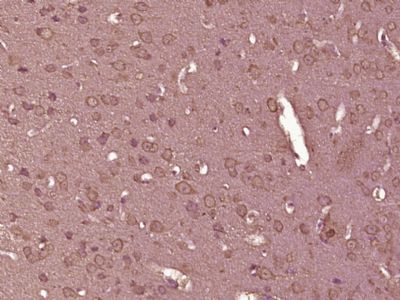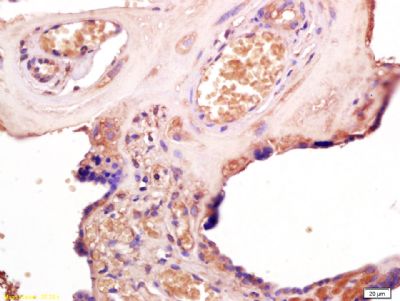产品中心
当前位置:首页>产品中心Anti-TLR3
货号: bs-1444R 基本售价: 380.0 元 规格: 20ul
- 规格:20ul
- 价格:380.00元
- 规格:50ul
- 价格:780.00元
- 规格:100ul
- 价格:1380.00元
- 规格:200ul
- 价格:2200.00元
产品信息
- 产品编号
- bs-1444R
- 英文名称
- TLR3
- 中文名称
- Toll样受体3抗体
- 别 名
- Toll-like receptor 3; TLR3; CD283; CD283 antigen; TLR 3; Toll Like Receptor 3; TLR3_HUMAN.

- Specific References (3) | bs-1444R has been referenced in 3 publications.[IF=2.20] Zhu, W., et al. "Overexpression of Toll?\Like Receptor 3 in Spleen is Associated with Experimental Arthritis in Rats."Scandinavian Journal of Immunology 76.3 (2012): 263-270.. WB ; Rat.PubMed:22702720[IF=4.60] Wang, Shaolan, et al. "Xenobiotic receptor PXR regulates innate immunity via activation of NLRP3 inflammasome in vascular endothelial cells." Journal of Biological Chemistry (2014): jbc-M114. WB ; Human.PubMed:25202020[IF=4.03] Zhu, Wenhua, et al. "Pristane induces autophagy in macrophages, promoting a STAT1-IRF1-TLR3 pathway and arthritis." Clinical Immunology (2016). WB ; Rat.PubMed:27940139
- 规格价格
- 50ul/780元购买 100ul/1380元购买 200ul/2200元购买 大包装/询价
- 说 明 书
- 50ul 100ul 200ul
- 研究领域
- 细胞生物 免疫学 染色质和核信号 微生物学 信号转导
- 抗体来源
- Rabbit
- 克隆类型
- Polyclonal
- 交叉反应
- Human, Mouse, Rat, Dog, Pig,
- 产品应用
- ELISA=1:500-1000 IHC-P=1:400-800 IHC-F=1:400-800 IF=1:100-500 (石蜡切片需做抗原修复)
not yet tested in other applications.
optimal dilutions/concentrations should be determined by the end user.
- 分 子 量
- 100kDa
- 细胞定位
- 细胞膜
- 性 状
- Lyophilized or Liquid
- 浓 度
- 1mg/ml
- 免 疫 原
- KLH conjugated synthetic peptide derived from human TLR3:801-905/905 <Cytoplasmic>
- 亚 型
- IgG
- 纯化方法
- affinity purified by Protein A
- 储 存 液
- 0.01M TBS(pH7.4) with 1% BSA, 0.03% Proclin300 and 50% Glycerol.
- 保存条件
- Store at -20 °C for one year. Avoid repeated freeze/thaw cycles. The lyophilized antibody is stable at room temperature for at least one month and for greater than a year when kept at -20°C. When reconstituted in sterile pH 7.4 0.01M PBS or diluent of antibody the antibody is stable for at least two weeks at 2-4 °C.
- PubMed
- PubMed
- 产品介绍
- background:
The protein encoded by this gene is a member of the Toll-like receptor (TLR) family which plays a fundamental role in pathogen recognition and activation of innate immunity. TLRs are highly conserved from Drosophila to humans and share structural and functional similarities. They recognize pathogen-associated molecular patterns (PAMPs) that are expressed on infectious agents, and mediate the production of cytokines necessary for the development of effective immunity. The various TLRs exhibit different patterns of expression. This receptor is most abundantly expressed in placenta and pancreas, and is restricted to the dendritic subpopulation of the leukocytes. It recognizes dsRNA associated with viral infection, and induces the activation of NF-kappaB and the production of type I interferons. It may thus play a role in host defense against viruses. Use of alternative polyadenylation sites to generate different length transcripts has been noted for this gene.
Function:
Key component of innate and adaptive immunity. TLRs (Toll-like receptors) control host immune response against pathogens through recognition of molecular patterns specific to microorganisms. TLR3 is a nucleotide-sensing TLR which is activated by double-stranded RNA, a sign of viral infection. Acts via MYD88 and TRAF6, leading to NF-kappa-B activation, cytokine secretion and the inflammatory response.
Subunit:
Interacts with MYD88 via their respective TIR domains. Interacts (via transmembrane domain) with UNC93B1. Interacts with TICAM1. Homodimer formation is triggered by ligand binding and is required for TLR3 signaling. Binding of double-stranded RNA is required for the interaction with SRC.
Subcellular Location:
Endoplasmic reticulum membrane; Single-pass type I membrane protein. Endosome membrane.
Tissue Specificity:
Expressed at high level in placenta and pancreas. Also detected in CD11c+ immature dendritic cells. Only expressed in dendritic cells and not in other leukocytes, including monocyte precursors. TLR3 is the TLR that is expressed most strongly in the brain, especially in astrocytes, glia, and neurons.
Post-translational modifications:
Heavily N-glycosylated, except on that part of the surface of the ectodomain that is involved in ligand binding.
DISEASE:
Defects in TLR3 are associated with herpes simplex encephalitis type 2 (HSE2) [MIM:613002]. HSE is a rare complication of human herpesvirus 1 (HHV-1) infection, occurring in only a small minority of HHV-1 infected individuals. HSE is characterized by hemorrhagic necrosis of parts of the temporal and frontal lobes. Onset is over several days and involves fever, headache, seizures, stupor, and often coma, frequently with a fatal outcome. Note=TLR3 mutations predispose otherwise healthy individuals to isolated herpes simplex encephalitis through a mechanism that involves impaired IFNs production and reduced immune defense against viral infection in the central nervous system.
Similarity:
Belongs to the Toll-like receptor family.
Contains 22 LRR (leucine-rich) repeats.
Contains 1 LRRCT domain.
Contains 1 LRRNT domain.
Contains 1 TIR domain.
SWISS:
Q99MB1
Gene ID:
7098
Database links:Entrez Gene: 7098 Human
Entrez Gene: 142980 Mouse
Omim: 603029 Human
SwissProt: O15455 Human
SwissProt: Q99MB1 Mouse
Unigene: 657724 Human
Unigene: 33874 Mouse
Important Note:
This product as supplied is intended for research use only, not for use in human, therapeutic or diagnostic applications.
Toll样受体3(TLR3)作为一种重要跨膜信号转导受体参 与了内毒素诱发炎症反应的病理过程.
- 产品图片
 Paraformaldehyde-fixed, paraffin embedded (Mouse brain); Antigen retrieval by boiling in sodium citrate buffer (pH6.0) for 15min; Block endogenous peroxidase by 3% hydrogen peroxide for 20 minutes; Blocking buffer (normal goat serum) at 37°C for 30min; Antibody incubation with (TLR3) Polyclonal Antibody, Unconjugated (bs-1444R) at 1:400 overnight at 4°C, followed by operating according to SP Kit(Rabbit) (sp-0023) instructionsand DAB staining.
Paraformaldehyde-fixed, paraffin embedded (Mouse brain); Antigen retrieval by boiling in sodium citrate buffer (pH6.0) for 15min; Block endogenous peroxidase by 3% hydrogen peroxide for 20 minutes; Blocking buffer (normal goat serum) at 37°C for 30min; Antibody incubation with (TLR3) Polyclonal Antibody, Unconjugated (bs-1444R) at 1:400 overnight at 4°C, followed by operating according to SP Kit(Rabbit) (sp-0023) instructionsand DAB staining. Tissue/cell: human placenta tissue; 4% Paraformaldehyde-fixed and paraffin-embedded;
Tissue/cell: human placenta tissue; 4% Paraformaldehyde-fixed and paraffin-embedded;
Antigen retrieval: citrate buffer ( 0.01M, pH 6.0 ), Boiling bathing for 15min; Block endogenous peroxidase by 3% Hydrogen peroxide for 30min; Blocking buffer (normal goat serum,C-0005) at 37℃ for 20 min;
Incubation: Anti-TLR3 Polyclonal Antibody, Unconjugated(bs-1444R) 1:200, overnight at 4°C, followed by conjugation to the secondary antibody(SP-0023) and DAB(C-0010) staining

